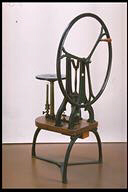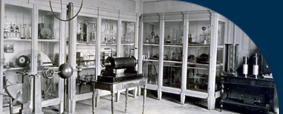|
OUR COLLECTION OF SCIENTIFIC INSTRUMENTS
PHYSICS OF THE AERIFORM, PNEUMATICS |

 |
Pneumatic machine with one cylinder |
 |
Macchina pneumatica ad un cilindro |
| Subject: pneumatics |
Settore: pneumatica |
| Number of catalogue: 123 |
Numero di inventario: 123 |
| Stamped on the lower part of the cast-iron tripod: "Dell'Acqua Milano"; On the back of the cast-iron frame: "Carlo Dell'Acqua Milano" [metallic plaque] |
Centralmente, sulla base inferiore del tripode in ghisa: "Dell'Acqua Milano" [Stampigliato]; sul telaio posteriore di ghisa: "Carlo Dell'Acqua Milano" [etichetta metallica] |
| c. 1863 |
Periodo di costruzione: 1863 circa |
| Cast-iron, brass, walnut, glass |
Materiali utilizzati: Ghisa, ottone, noce, vetro |
| 850 X 750 X 1500 [mm] |
Dimensioni: 850 X 750 X 1500 [mm] |
| |
|
The machine is signed by Carlo Dell'Acqua (1806-?), one of the most important instrument-makers of the first half of the 19th century. Until 1859 Dell'Acqua was mechanician and technician in the School of Physics of the Royal Gymnasium of St. Alessandro in Milan and later held the post of machinist at the Royal Astronomical Observatory in Brera. He received praise and awards from several Italian and foreign Institutions for his instruments featured at the Universal Exhibition of Paris in 1855. Before the establishment of "Tecnomasio", his workshop supplied many public and private institutions, schools, colleges and universities with excellent instruments of physics. His 1863 catalogue (fifth edition) contains a wide range of instruments and machines (857 items) for use in physics laboratories. In 1863 Dell'Acqua founded together with the civil and mechanical engineer Luigi Longoni and with the optician and photographer Alessandro Duroni, the "Tecnomasio Italiano", which was the most important mechanical workshop of scientific instruments in Italy in the second half of the 19th century. From some marginal notes in his catalogue, it is evident that he had committed himself to the improvement of pneumatic machines since 1845 and that he had received great praise from the Royal Lombardic Institute of Sciences, Literatures and Arts (1851), from the jury of the Universal Exhibition of Paris in 1855 and from the National Academy of Paris (1857). |
La macchina porta la firma di Carlo Dell'Acqua (1806-?) uno dei costruttori italiani più importanti della prima metà del XIX secolo. Il Dell'Acqua fu meccanico-preparatore -fino al 1859- della Scuola di fisica del Regio Liceo di Sant'Alessandro in Milano e successivamente ricoprì il posto di macchinista presso il Regio Osservatorio Astronomico di Brera. I suoi strumenti ricevettero encomii e premi da diverse Istituzioni italiane e straniere e ben figurarono all'Esposizione Universale di Parigi del 1855. Prima della fondazione della ditta Tecnomasio, la sua officina rifornì di buoni strumenti di fisica numerosissime istituzioni pubbliche e private, scuole, collegi ed Università; il suo catalogo del 1863 (quinta edizione) riporta, con vasto assortimento, 857 voci tra strumenti e macchine fisiche ad uso per i Gabinetti di fisica. Nel 1863 il Dell'Acqua fondò, unitamente all'ingegnere civile e meccanico Luigi Longoni e all'ottico e fotografo Alessandro Duroni, il Tecnomasio Italiano, che fu in Italia la più importante officina meccanica di strumentazione scientifica della seconda metà del XIX secolo. Da alcune note di estratti, a margine del suo catalogo, sappiamo che egli si prodigò nel perfezionamento delle macchine pneumatiche fin dal 1845, ricevendo lusinghieri giudizi dal R. Istituto Lombardo di Scienze Lettere ed Arti (1851), dal Giurì per l'Esposizione Universale di Parigi del 1855 e dall'Accademia Nazionale di Parigi (1857). |
| |
|
Description: The pump is mounted on a thick walnut base supported by a wide cast-iron tripod. The pump consists of a solid vertical crystal cylinder (open on its top) within which an airtight piston can move. The bottom of the piston is linked, by means of a tube with a pin, to the plate of the pneumatic machine. The degree of rarefaction achieved can be read through a manometer, which is substantially a siphone barometer contained within a small glass bell (with a scale divided into mm Hg 80-0-80) and which communicates with the plate. The plate is provided with two rheofores under its base for the supply of current, under the glass bell, for those experiments requiring electrical current. |
Descrizione: la pompa è montata su una spessa base in noce sostenuta da un ampio tripode in ghisa. Essa è costituita da un solido cilindro verticale in cristallo (aperto alla sua sommità) entro cui si muove uno stantuffo a tenuta d'aria il cui fondo è in comunicazione, mediante un condotto munito di chiave, con il piatto della macchina pneumatica. Il grado di rarefazione raggiunto è leggibile mediante un manometro, essenzialmente un barometro a sifone alloggiato entro una piccola campana di vetro (con scala in mm Hg 80-0-80) e comunicante con il piatto. Questo è munito sotto la sua base di due serrafili per l'alimentazione sotto la campana di vetro di esperienze che necessitano di corrente elettrica. |
| |
|
Function: The alternating motion of the piston is achieved through the manual rotation of a large cast-iron flywheel (Ø = 85 cm). The handle, through the action of a crankshaft, controls a connecting rod that, in turn activates the alternated motion of the piston. The piston is provided with some automatic valves, which mechanically make the barrel evacuate without the need for a level of pressure that is higher than the atmospheric pressure. |
Funzionamento: il moto alternativo dello stantuffo si ottiene mediante la rotazione manuale di un grande volano in ghisa (Ø = 85 cm) con manico che comanda mediante un albero a gomito una biella per il moto alternativo dello stantuffo. Questo è munito di alcune valvole automatiche che esplicano meccanicamente l'evacuazione del cilindro, senza bisogno che su di esse si eserciti una pressione superiore all'atmosferica. |
| |
|
Bibliography: Dell'Acqua [1863], introduction, pp. 7-48; Scientific and industrial year-book [1866], pp. 507-508. |
Bibliografia: Dell'Acqua [1863], prefazione, pp. 7-48; Annuario [1866], pp. 507-508. |
|
|
|

